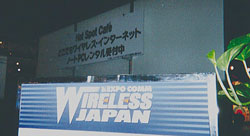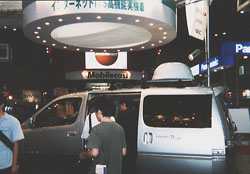Report on "Wireless Japan 2002"
Takahiro Miyao (Professor, GLOCOM)
 Wireless Japan 2002, an annual event with the largest exhibition of hardware and software for mobile/wireless technologies and business in Japan, was held at Tokyo Big Sight on July 17-19, 2002. The main theme of this event was mobile/wireless broadband communications with a claim that "the new stage of wireless broadband age is launched from this event": See http://www.ric.co.jp/expo/wj2002/index.html. Wireless Japan 2002, an annual event with the largest exhibition of hardware and software for mobile/wireless technologies and business in Japan, was held at Tokyo Big Sight on July 17-19, 2002. The main theme of this event was mobile/wireless broadband communications with a claim that "the new stage of wireless broadband age is launched from this event": See http://www.ric.co.jp/expo/wj2002/index.html.
However, as pointed out by Chuo University Professor Shigehiko Naoe, who gave a talk at the main conference on July 18, this theme is a little too late from the technological viewpoint, but may be a little too early from the business viewpoint. Or more appropriately, there was no clear focus in this event this year, as 3G Internet cell phones are not selling well, while wireless LAN services are not yet making money in Japan.
Again there was no clear consensus that emerged from the main conference, where Keiji Tachikawa, President of NTT DoCoMo, talked about his mobile/multimedia strategy, emphasizing only a bright future for 3G FOMA without even hinting a problem in globalization or competition with non-3G technologies. In contrast, other speakers such as Prof. Naoe of Chuo University pointed out various problems associated with cell-phone-type business models and future prospects for more open Internet-type wireless broadband business models.
 Still, the exhibition itself was attracting quite a large number of people, especially to such featured demonstrations as 3G mobile phones which could display movie images and GPS information, and ITS for automobile/road traffic information. Regarding ITS, there was a van with a special antenna, where a number of computers inside were connected to broadband services (see the photo). This might be called a mobile "PC Van," as compared to Korea's fixed "PC Bang" (Broadband Internet centers). Still, the exhibition itself was attracting quite a large number of people, especially to such featured demonstrations as 3G mobile phones which could display movie images and GPS information, and ITS for automobile/road traffic information. Regarding ITS, there was a van with a special antenna, where a number of computers inside were connected to broadband services (see the photo). This might be called a mobile "PC Van," as compared to Korea's fixed "PC Bang" (Broadband Internet centers).
Probably the most visible phenomenon on the exhibition floor was people's strong interest in wireless LAN service in general, as they were flocking to free seminars on applications of wireless LAN service and also to a "Hot Spot" café, where both (IEEE802.) 11a and 11b could be used at the speed of 36Mbps. The fact that these free events were most popular might imply that it would take some more time to find a profitable business model for wireless broadband communications.
|





